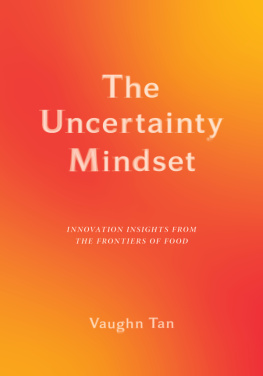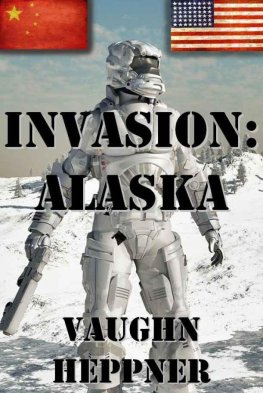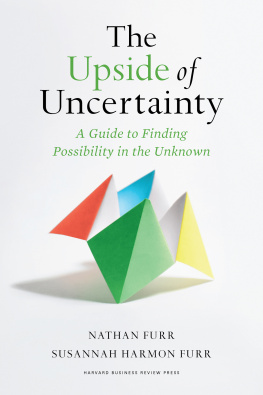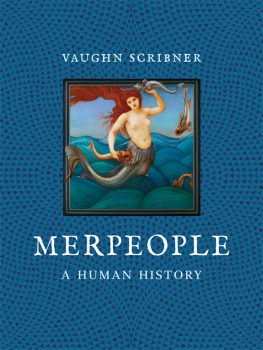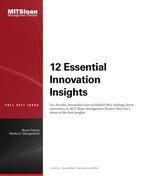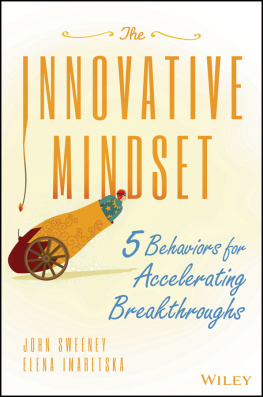Table of Contents
THE
UNCERTAINTY
MINDSET
THE
UNCERTAINTY
MINDSET
INNOVATION INSIGHTS FROM
THE FRONTIERS OF FOOD
VAUGHN TAN
Columbia University Press New York
Columbia University Press
Publishers Since 1893
New York Chichester, West Sussex
cup.columbia.edu
Copyright 2020 Vaughn Tan
All rights reserved
E-ISBN 978-0-231-55187-8
Library of Congress Cataloging-in-Publication Data
Names: Tan, Vaughn, author.
Title: The uncertainty mindset : innovation insights from the frontiers of food / Vaughn Tan, School of Management, University College London.
Description: [New York City] : [Columbia University Press], 2019. | Includes bibliographical references and index.
Identifiers: LCCN 2019057472 | ISBN 9780231196888 (hardback) | ISBN 9780231196895 (trade paperback) | ISBN 9780231551878 (ebook)
Subjects: LCSH: Restaurant management. | RestaurantsTechnological innovations. Classification: LCC TX911.3.M27 T36 2019 | DDC 647.95068/4dc23
LC record available at https://lccn.loc.gov/2019057472
A Columbia University Press E-book.
CUP would be pleased to hear about your reading experience with this e-book at .
Cover design: Vaughn Tan
CONTENTS
I n November 2010, I visited my first culinary research and development (R&D) team. Several months earlier I had met Jos Andrs, ThinkFoodGroups head chef and cofounder, at a talk he had given at Harvard. I went to breakfast with Andrs the day after, during which he mentioned offhand that ThinkFoodGroups success was largely due to their investment in a dedicated R&D team based at their Washington, DC headquarters. Over ham and eggs, I somehow convinced Andrs to let me spend a few weeks with them.
As soon as I got out of the airport, I beelined downtown to the cluster of restaurants owned by ThinkFoodGroup, a rapidly growing international restaurant group with an innovation lab. It had begun to gust and rain heavily when I emerged from the Penn Quarter subway station. Fortunately, Oyamel, the restaurant Id been instructed to go to, was only a few blocks away and the ranks of midrise office and apartment buildings kept some of the rain from street level. Russell Bermel, then Andrss assistant, met me at the door and took me through the brightly daylit, blue and white, ground-floor dining room filled with lunchers happy under a ceiling mobile of gently moving butterfliesforests of oyamel, the sacred firs, are one of the principal wintering grounds for the monarch butterfly in highland Mexico. Then we descended into the basement kitchen, where the R&D chefs were working that day.
The large, but nonetheless cramped, low-ceilinged, windowless room was lit by bright fluorescent light. It was filled with the noise, heat, and movement of a kitchen in the middle of a lunch rush, and the floor had become slick with water and a thin film of grease. Skirting line cooks, busboys, and potwashers, we eventually came to the farthest corner of the kitchen where the walk-in refrigerator was located. There, we joined two chefs who stood looking annoyed at five bowls and three binders of recipes laid out on a battered stainless steel prep table that had been temporarily commandeered from the vegetable prep cook. As I was about to introduce myself, we heard a shouted, Backs! and Bermel pulled me up against the table with the others to get out of the way of a frenzied line cook who ran past us to the walk-in, wrenched open the door, snatched up a tray of prebraised pork, and ran with it back to his station before the door had swung fully shut. Bermel said, Welcome to the ThinkFoodTank.
My first impression of the ThinkFoodTank when I saw it in Oyamels basement was of a haphazard, ramshackle operation. As an organizational researcher, I did not expect to rapidly discover an innovation team both more creative and more effective than the product innovation teams Id been a part of at Googlemuch less one organized in ways that violate many conventional innovation management principles. But once I saw past these superficials, I realized that it was a team of rare quality: fast-moving, adaptable, intensely curious, self-organizing, and highly effective. It just happened to be organized in ways that were not only unexpected but in fact ran counter to what I expected from having worked in a supposedly highly innovative technology firm and from being immersed in conventional innovation management theory.
The conventional approach to designing an innovation team is to assemble it with great care from handpicked employees, isolate it from the rest of the organizations distractions and politics, and give it plenty of resources. The ThinkFoodTank, by contrast, was scrappy, small, and lightly resourced. It worked wherever space could be found, drew experts from across and outside the group as needed, and was tightly integrated into the daily operations of ThinkFoodGroups many restaurants and new openings. It had evolved this unconventional but effective way of organizing innovation work without advice from management experts.
The ThinkFoodTank violated so much conventional wisdom that I returned several times in 2010 and 2011 to try and make sense of how it worked at alllet alone as well as it did. I eventually spent over a month with ThinkFoodTank as it moved around the groups restaurants, seamlessly introducing process innovations and launching new restaurants with apparent ease despite the tremendous number of moving parts involved. Early on, Andrs had described his R&D team as Delta Force. I quickly saw what he meant. ThinkFoodTank functioned at a high level even when unpredictable work was thrown at itit was an innovation dream team.
ThinkFoodTank was so surprising that it made me want to see if other culinary innovation groups worked in similar ways. Between 2011 and 2016, I spent time observing the inner workings of some of the best cutting-edge culinary innovation teams in the worldacclaimed by consumers, critics, peers in the high-end culinary industry, and observers in science, technology, and innovation. In the United States, other than ThinkFoodGroup, I went to The Cooking Lab (publishers of Modernist Cuisine: The Art and Science of Cooking, Modernist Cuisine at Home, and Modernist Bread). Outside the United States, I went repeatedly to Amaja (a restaurant in southern Argentina that worked closely with a culinary R&D team called the Patagonia Food Lab; both are pseudonyms) and the Fat Ducks Experimental Kitchen in the United Kingdom, and worked with the MAD Foundation in Denmark (an organization spun off from the cutting-edge Danish restaurant Noma and which convenes the MAD Symposium, the pre-eminent international cutting-edge culinary conference).
As an organizational sociologist studying innovation teams, I was steeped in conventional management theory that emphasizes carefully designing R&D teams so they contain the correct people, providing them with the correct resources, and identifying the correct targets for innovation work. Conventionally well-managed organizations can be highly efficient, but only when conditions are predictable, stable, and controllable. But innovation is not about efficiency, and reality is seldom so accommodating.



